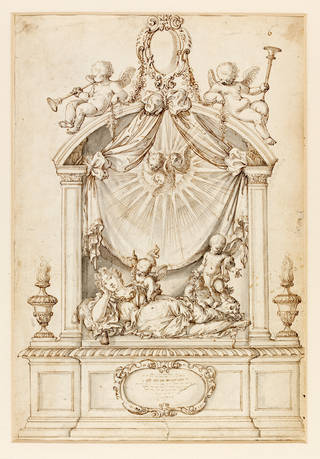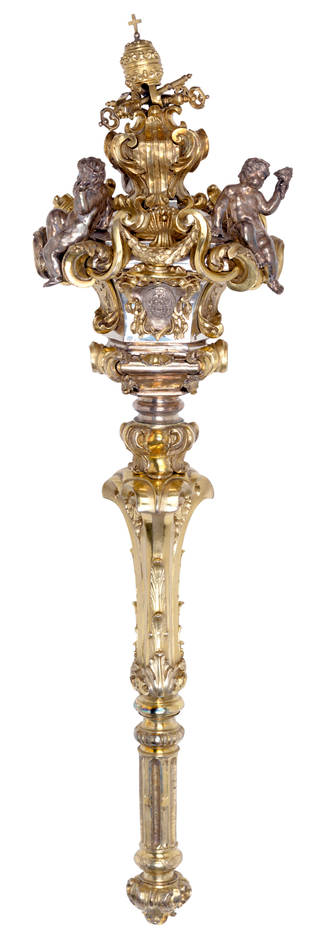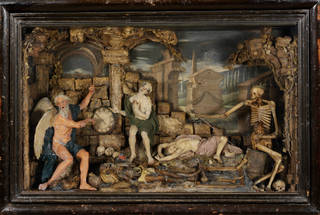The Baroque style flourished thanks to the patronage of the Roman Catholic Church. Promoted by generations of popes, cardinals, priests, missionaries and worshippers, the style spread around the world.
Baroque religious art was not only visible in churches, it was also seen on street corners and squares, on shrines and public statues as well as being carried in processions. Although the Baroque style was closely associated with the power and authority of the Catholic church, it would also have been familiar to many Protestants.
Baroque employed painting, sculpture, architecture and the decorative arts along with music and poetry to appeal to all of the senses. Seeking a combined effect, these 'total works of art' were intended both to impress and move their viewer. Baroque religious objects not only inspired devotion, they also brought honour to those who commissioned them as well as the craftsmen and artists who created them.
Rome and the papacy
Baroque Rome was the headquarters of the Roman Catholic church. Like princes, the popes used their patronage to wield power. They spent vast sums on building projects, art commissions and establishing collections. Some popes set artistic trends by favouring particular artists, art media and subjects. Gianlorenzo Bernini (1598 – 1680) worked for a succession of popes and was known particularly for his uniting of sculpture, painting and architecture in works such as the Cornaro Chapel and in his designs for St Peter's Basilica in Rome.
The V&A's collection includes two busts by the Italian sculptor Domenico Guidi representing Pope Innocent X (reigned 1644 – 55) and Pope Alexander VIII (reigned 1689 – 91). The sweeping vestments and Baroque naturalism give the portrait busts immense presence and power. Papal busts of this type were regularly made in the Vatican's foundry.

Inside the Baroque church
On entering a Baroque church, the worshipper met with a space of dramatic intensity that expressed the triumph of the Catholic Church. A vast array of materials were used for decoration: bronze railings and lighting, silver ceremonial objects, and carved and decorated wood for seating and framing pictures. Almost all surfaces were painted or gilded, embroidered textiles were used as hangings, vestments and covers, and sculptures of wood, stone, metal, clay or plaster were set on and around the altars.
Many spaces within the church were turned over to commemorative use. The popes and their families competed with each another to secure prestigious burial places in the most important churches in Rome and to erect impressive funeral monuments.
The elaborate nature of funerary monuments is shown by a design in our collection for a monument to commemorate Lady Dorothy Brownlow (1665 –99/1700), wife of Sir William Brownlow. Situated in the English church of St Nicholas, Sutton, the monument is described by John Aubrey in his The Natural History and Antiquities of the County of Surrey (1718) as a:
"beautiful Marble Monument railed in, whereon lies, at full length, a Lady leaning on her left Arm, and by her three Children, two weeping, and one pointing to a Glory surrounded with Cherubims on a Curtain, on the Top two Cupids with Golden Trumpets; on each side two Urns"
An inscription on the monument establishes Lady Brownlow's lineage. Social elites used such monuments to reinforce their social ranking.

The performance of the Mass
Performance was as prominent in the sacred spaces of chapels and churches as it was in the theatre. During Mass – performed to commemorate Christ's sacrifice on the cross – Catholics believe the 'Host' (a small, flat wafer symbolising the bread of the Last Supper) and the wine miraculously become the body and blood of Christ. In typical Baroque fashion, the 'Host' would have been displayed to the congregation by placing it in the central window (the 'lunula'), of a highly decorative object called a monstrance. The monstrance would have been placed on the altar as a focus for worship, or held up during church processions for the congregation to see.
This example in our collection was made by Johann Zeckel, who was one of the leading goldsmiths of the time in Augsburg, Bavaria. It is elaborately decorated with imagery associated with Christ. The plaque beneath the central window shows the Last Supper, in which Christ shared bread and wine with his disciples, saying, "This is my body and blood". The cornucopias – horns on either side of the monstrance – contain grapevines and ears of corn and symbolise the wine and bread of the service. As the altar was central to this ritual, they were often given considerable attention from patrons and artists, such as the bronze 'baldachin' or canopy, that Bernini designed for the altar of St. Peter's Basilica in Rome.

The significance of saints
Within the Catholic Church, saints were seen as important role models whose actions could educate and inspire. Newly created saints, who had been missionaries, were especially important. Within churches, holy vessels were produced to tell their story and to protect and display bodily relics. Another popular motif was the Virgin Mary. Baroque artists developed different images of Mary, in the role of mother, sister or daughter. One of her most popular 17th-century personifications was 'Virgin of Sorrows', where she was depicted anguished, suffering and alone. Busts of the sorrowful Virgin were often placed in the side chapels of churches as a focus for private devotion, perhaps alongside a similar bust of Christ displaying his wounds. Our collection includes a Spanish bust of the 'Virgin of Sorrows' ingeniously constructed from ivory, glass and painted pinewood to look as lifelike as possible. While some of the sculpture's original colour has been lost – traces of tears might well have once been visible on the cheeks – its simple power is still intact. The bust exemplifies how artists could convey intense emotion through apparently plain, naturalistic forms. Its realistic appearance would have encouraged worshippers to imagine the Virgin's sorrow at her son's suffering as their own.

Religious ceremony outside the church

Religious devotion did not only take place in church. Just as processions were used for secular displays of power, the Church used them for significant religious occasions, such as to mark Holy Week or saints' days, where carved and painted wooden sculptures were carried through the streets.
Our collection includes a ceremonial mace, or ornamental staff, made for a cardinal on his appointment to symbolise his authority. A special bearer would have carried it during ceremonial processions and it is designed to impress, weighing nearly ten kilograms. The mace would originally have included the coat of arms of the cardinal who owned it and of the pope who appointed him. Such maces were often re-used, with the arms changed to reflect their new ownership. This mace includes a shield with the name of Pope Pius VII, who consecrated Napoleon I as Emperor at Paris in 1804, and the arms of Cardinal Oppizzoni, who took a prominent part in Napoleon's coronation as King of Italy at Milan in 1805. It's believed that it was used on both those occasions.
Private devotion
Christians of all denominations were encouraged to engage in spiritual improvement and renewal. Many devotional exercises were undertaken in private and were facilitated by images and other works of art, which could include everything from simple wooden crosses to costly bejewelled treasures.
A macabre wax relief tableau of Time and Death in our collection was created to remind the viewer of the transience of life and worldly glory. The scene depicts the winged figure of Father Time and a crowned skeleton representing Death, surrounded by discoloured and decaying corpses in a crumbling graveyard. While wax was widely used in Naples for sculpting small-scale Nativity scenes, only a handful of these 'little theatres of death' are known to have survived. Caterina de Julianis, a Neapolitan nun who specialised in wax modelling – an ideal medium for such morbid subject matter – probably made this macabre depiction. It shows how much sacred art was part of everyday life, rather than simply being confined to the spaces of the church.



